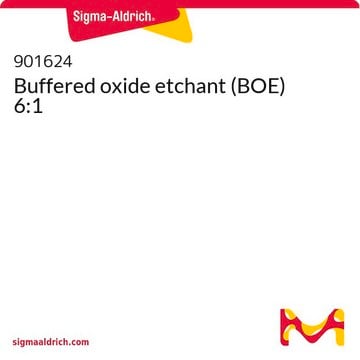338869
Ammonium fluoride
≥99.99% trace metals basis
Synonim(y):
Ammonia Hydrofluoride, Azanium fluoride
About This Item
Polecane produkty
Próba
≥99.99% trace metals basis
Postać
crystals and lumps
zanieczyszczenia
≤100 ppm METAL TRACE ANALYSIS (ICP)
ciąg SMILES
N.F
InChI
1S/FH.H3N/h1H;1H3
Klucz InChI
LDDQLRUQCUTJBB-UHFFFAOYSA-N
Szukasz podobnych produktów? Odwiedź Przewodnik dotyczący porównywania produktów
Powiązane kategorie
Opis ogólny
Zastosowanie
- To modify the interface between the electron transport layer and the perovskite layer of solar cells. This helps to reduce interfacial defects and charge recombination enhancing power conversion efficiency of perovskite solar cells (PSCs).
- As a structure directing agent to prepare electroactive materials for supercapacitors.
- To synthesize NiF2/porous carbon (NPC) nanocomposite by a bottom-up method for cathodes of Li-ion battery. Heat treatment with NH4F produces a high yield of metal fluoride/porous carbon nanocomposites.
Hasło ostrzegawcze
Danger
Zwroty wskazujące rodzaj zagrożenia
Zwroty wskazujące środki ostrożności
Klasyfikacja zagrożeń
Acute Tox. 3 Dermal - Acute Tox. 3 Inhalation - Acute Tox. 3 Oral
Kod klasy składowania
6.1C - Combustible acute toxic Cat.3 / toxic compounds or compounds which causing chronic effects
Klasa zagrożenia wodnego (WGK)
WGK 1
Temperatura zapłonu (°F)
does not flash
Temperatura zapłonu (°C)
does not flash
Środki ochrony indywidualnej
Eyeshields, Faceshields, Gloves, type P2 (EN 143) respirator cartridges
Certyfikaty analizy (CoA)
Poszukaj Certyfikaty analizy (CoA), wpisując numer partii/serii produktów. Numery serii i partii można znaleźć na etykiecie produktu po słowach „seria” lub „partia”.
Masz już ten produkt?
Dokumenty związane z niedawno zakupionymi produktami zostały zamieszczone w Bibliotece dokumentów.
Nasz zespół naukowców ma doświadczenie we wszystkich obszarach badań, w tym w naukach przyrodniczych, materiałoznawstwie, syntezie chemicznej, chromatografii, analityce i wielu innych dziedzinach.
Skontaktuj się z zespołem ds. pomocy technicznej








